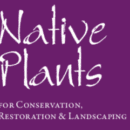Tomorrow is a special day for me at the Forest Farmers Market! I will be at our Master Gardener’s information table. Our week’s theme is about how & why to add Native Plants to landscapes. The Children’s table has a quick take-home Monarch project along with hands-on information about Monarchs and the Native plants that they visit.
Master Gardeners are specially trained Cooperative Extension volunteers. Come over, ask about any horticultural problems or questions that you may have. It’s also OK to just stop by and say hello!
This post is dedicated to sharing excellent go-to resources on Saturday’s subjects.
Happy Digging,
KathyN, Bedford Extension Master Gardener volunteer
PS Join us again next week (Wednesday) to read an article specifically about Deer-resistant Native plants!
NATIVE PLANTS
Ladybird Johnson Wildflower Center The home page shows “Native Plants” as a main category. I LOVE this site! Look for kid-friendly information as well.
Native Plants for Conservation, Restoration & Landscaping This brochure is specific to our Virginia Mountain region. It contains an extensive list ranging from herbs to trees. A must-keep!
Native Plants for Southeast Virginia including Hampton Roads Region Great material that we all can make use of right here in Central Virginia.
Native Plants for Wildlife Habitat and Conservation Landscaping Wonderful listings with beautiful photos. A free, downloadable booklet.
“This publication includes those pictures as well as user-friendly information on native species… this guide displays the great diversity of plants available. We hope you will bypass the over-used, non-native and sometimes invasive ornamental plants, and select the equally and often more attractive native plants. Pour through this guide the same way you look through nursery catalogs. Use it to plan and design your next planting, whether it’s a small corner of your front yard, a two-acre meadow seeding, or 100 acres of wetland restoration.”
What Are Native Plants? This is a quality Department of Conservation and Recreation publication.
“…Native plants possess certain traits that make them uniquely adapted to local conditions, providing a practical and ecologically valuable alternative for landscaping, conservation and restoration projects, and as livestock forage. In addition, native plants can match the finest cultivated plants in beauty, while often surpassing non-natives in ruggedness and resistance to drought, insects and disease…”
Virginia Native Plant Society Thinking of joining? This group has a local chapter! The website also has a list of nurseries that propagate native species.
“The VNPS is dedicated to the protection and preservation of the native plants of Virginia and their habitats, in order to sustain for generations to come the integrity of the Commonwealth’s rich natural heritage of ecosystems and biodiversity for purposes of enjoyment, enlightenment, sustainable use, and our own very survival.”
THE MONARCH BUTTERFLY
Monarch Watch: Monarch Waystation Program
“Monarch Waystations are places that provide resources necessary for monarchs to produce successive generations and sustain their migration…” Find out how easy and beautiful it is to be a part of the program.
How To Create A Monarch Waystation by AmericanMeadows.com
“A Monarch Waystation is an intentionally-managed garden that provides food and habitat for the struggling Monarch butterfly population. As a rule, a waystation must include at least 2 types of Milkweed, the ‘host’ plant for Monarchs…”
The Butterfly Society of Virginia
- Education – Study and learn more about butterflies and moths. Raise the general consciousness of the survival problems of butterflies and moths through publicity, programs and activities for both adults and children.
- Conservation – Promote butterfly and moth conservation, including conservation of habitat and host and nectar gardens.
- Gardening – Encourage the planting of butterfly and moth host and nectar plants in home and public gardens.
- Volunteering – Support the butterfly gardens and programs of the Norfolk Botanical Garden and other appropriate organizations throughout the State.
Monarch Nectar Plant Guide: Mid-Atlantic If you’re not familiar with The Xerces Society’s publications, make sure to spend a worthwhile few minutes to check this out!
“One of the most significant actions you can take to support monarch populations is providing nectar-rich flowers and milkweed host plants…”
Milkweeds and How to Grow Them From Seed This article from SaavyGardening shows how easy it can be to grow milkweed- I’ve done it this way, and it WORKS!
“Winter doesn’t necessarily seem like the best time to be starting seeds outdoors in most of North America, but for one very valuable group of plants – the milkweeds – winter is the perfect time to get planting…”
Attracting Pollinators to Your Garden A great booklet published by the U.S. Fish & Wildlife Service.
“What Can You Do for Pollinators? Plant a garden using native flowering plants:
- Choose a variety of colors and shapes that will attract a variety of pollinators
- Choose plants that flower at different times providing nectar and pollen sources throughout the growing season.
- Plant in clumps rather than single plants to better attract pollinators.”








